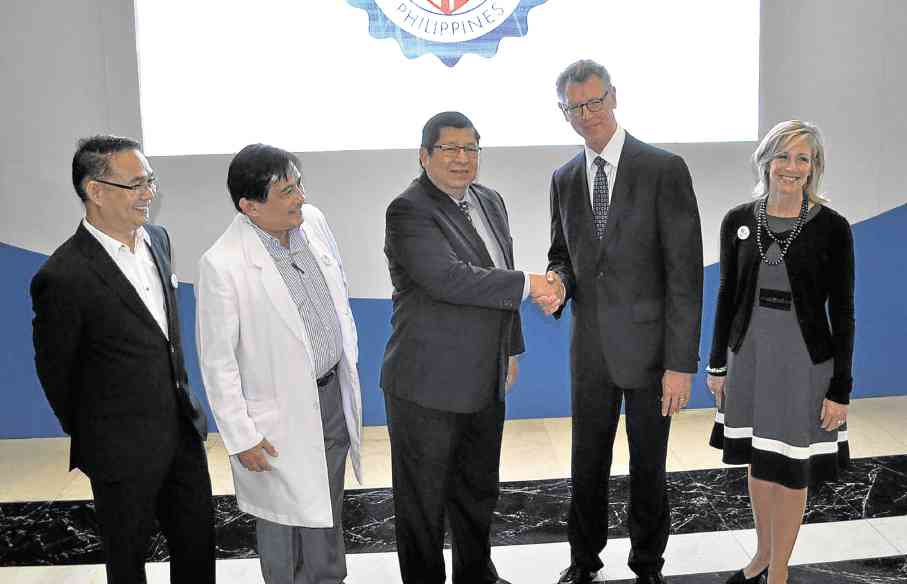St. Luke’s joins Mayo Clinic Care Network

SEALING THE DEAL. (From left) Cortez and Hayes seal the St. Luke’s-Mayo Clinic collaboration. Joining them is Lenae Barkey, Mayo Clinic Care Network administrative director
In the medical world, the 152-year-old Mayo Clinic is regarded as one of the best in its field.
And partnering with the Minnesota-based organization is St. Luke’s Medical Center, making it just the fifth partner-institution of the Mayo Clinic outside the US mainland.
Dr. Edgardo Cortez, president and CEO of SLMC, said the partnership would pave the way for a professional relationship that will benefit both patients and doctors.
Under the agreement, the hospital’s patients—in both Bonifacio Global City and Quezon City facilities—with medical cases regarded as most unusual, rare or very complex can be discussed with Mayo Clinic’s specialists through live video.
Collaboration
And this arrangement will not cost St. Luke’s patients.
“With this collaboration, we can share medical knowledge, have additional access to some of the world’s leading medical experts, and we can leverage this relationship so that these additional resources from Mayo Clinic can be offered to our patients to enhance the care we provide them at no additional cost to them,” said Cortez during the formal launch held at the hospital’s BGC facility.
As network affiliate, the 113-year-old St. Luke’s remains wholly independent and will only pay an annual subscription fee to let its doctors with special cases schedule consultation with Mayo Clinic’s specialists through eConsults, an electronic method for a Mayo Clinic specialist to answer a [St. Luke’s] doctor’s focused question about diagnosis, therapy or management through a review of the patient’s electronic medical record, imaging studies and laboratory tests.
A response usually takes two days, especially for those with acute cases.
Other available resources include AskMayoExpert, an online resource that delivers Mayo Clinic physician-vetted medical knowledge, answers to common clinical questions, and descriptions of care processes online, at the bedside, and at the point of care.
There’s also Healthcare Consulting, which provides advice on improving operations, vetting vendors and best practices and technologies.
St. Luke’s doctors could also avail themselves of the eTumor Board Conferences that allow them to present and discuss management of complex cancer cases with a Mayo Clinic multidisciplinary panel and other members of the network.
“We are pleased to welcome St. Luke’s Medical Center to the Mayo Clinic Care Network,” said Dr. David Hayes, medical director of the Mayo Clinic Care Network, “Patient-centered care is the foundation of both organizations. We look forward to working together to find new and innovative ways to enhance that care.”
Hayes added that thanks to this collaboration, a patient here in the Philippines needing a Mayo Clinic consultation will no longer have to fly right away to Minnesota.
With this collaboration, Mayo Clinic now has the opportunity to extend its geographic reach and reputation, a reason why it carefully vets potential network members, like St Luke’s, to determine if they operate under a philosophy similar to Mayo Clinic’s, are well run and financially stable.
“The process includes a lengthy application and site visits. Indeed, the inclusion of St. Luke’s in the Mayo Clinic Care Network brings us closer to realizing our vision of becoming an internationally recognized academic medical center,” said Cortez.
And the hospital is in good company: Launched in 2011, the Mayo Clinic Network currently has 44 affiliated hospitals mostly in the continental United States.
Aside from St. Luke’s, the affiliates outside the US are Raffles Medical Group in Singapore, the American Hospital Dubai in United Arab Emirates, Medica Sur in Mexico, and Salus in Puerto Rico.
Mayo Clinic has major campuses in Rochester, Minnesota; Scottsdale and Phoenix in Arizona; and Jacksonville, Florida. Just this August, the Mayo Clinic in Minnesota was named the top hospital in the United States, according to the US News & World Report Best Hospitals ranking for 2016-2017.
The 16 specialties used in the ranking are cancer, cardiology and heart surgery, diabetes and endocrinology, otolaryngology, gastroenterology and gastrointestinal surgery, geriatrics, gynecology, nephrology, neurology and neurosurgery, ophthalmology, orthopedics, psychiatry, pulmonology, rehabilitation, rheumatology, and urology.
